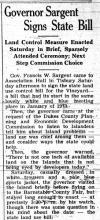Calling it an important step for the Vineyard and signaling a new determination to take the lead in regional transportation planning, the Martha’s Vineyard Commission voted with one voice last night to designate an Islandwide harbors and highways district of critical planning concern (DCPC).
“This DCPC proposal is a culmination of a lot of time and thinking about existing DCPCs and about the impact of the car and what it is doing to the Island roads,” declared MVC executive director Charles W. Clifford.
“And if we’re going to do seamless transportation,” he added, “we’ve just got to get off our backsides and come up with a system that will work.”
Mr. Clifford’s remarks came at the outset of a public hearing on a proposal to designate the transportation DCPC. The special planning district was nominated by the commission at the urging of Mr. Clifford last month.
The new DCPC includes all the major roads and harbors on the Vineyard.
The vote triggers a yearlong planning effort with an eye toward developing new regulations to protect the rural roads and also to reduce the number of cars traveling to the Vineyard in the summer months.
DCPCs also are accompanied by an automatic building moratorium, although Mr. Clifford admitted last night that in this case the moratorium is largely symbolic because it applies to roads and harbors, where no building occurs.
“I’m asking you folks to designate this so we can go forward with a planning exercise. . . . This is perhaps an expansion of what Kevin Lynch did many moons ago in Looking at the Vineyard,” Mr. Clifford said, referring to a conceptual planning book published some 25 years ago about the Island.
Mr. Clifford cited statistics. He said 18 per cent of the cars coming down the Woods Hole Road are bound for the Vineyard, and 70 per cent of those cars come to the Island for 14 days or less during the summer season.
He talked about getting people out of their cars — not just on the Cape, but at home. “We have a functioning transit system here, we have taxicabs, we have rental cars. That 70 per cent — we are hoping to create a system where those people can go to South Station and take the bus, take the train, and when they get to the Vineyard their baggage is waiting for them,” Mr. Clifford said.
A handful of people turned out for the public hearing.
“This discussion seems to lack two words — parking and docking,” said Art Flathers, a Tisbury resident who closely follows the affairs of the Steamship Authority.
Mr. Flathers said the number of registered cars on the Vineyard has risen dramatically in the last 10 years, and he also said the number of passengers carried on boat line ferries has increased far more than the number of cars and trucks.
“The problem is not the visitors,” Mr. Flathers said. He continued: “You have already done a lot in the last 10 years to reduce the number of people coming over in their cars. You may be barking up the wrong tree if you try to do a whole lot more. And you can talk about what you want to do to cut down on vehicle traffic, but let’s be honest about it — it’s a popular place.”
Mr. Clifford had a different view.
“There are a multitude of things we haven’t dealt with. And all I’m asking for here is the time to deal with it. I would like to be ahead of everybody else. Nantucket is talking about limiting the number of cars that come to the island. Catalina Island already does it. Let’s take the lead here and let everybody else catch up with us,” he said.
Mr. Clifford outlined two broad components of the transportation DCPC — to protect the rural and scenic Vineyard roads, and to develop a regional transportation plan for the Island harbors.
The discussion among commission members ranged from an examination of the map of Island roads included in the district, to a broader discussion of the planning goals of the DCPC.
“Part of the wonderful thing about this is that the towns will work together. This is legal, but it’s also beyond legal and the letter of the law. It’s what we are envisioning for the future of the Island,” said commission member Michelle Lazerow.
Commission member James Vercruysse asked how the staff work will be funded. “Is there staff to take on these studies, and where will the money come from?” he said.
Mr. Clifford said some funding will come out of the commission’s contract with the state highway department, and he said he intends to request more money from existing federal funds procured last year by Cong. William Delahunt. Mr. Clifford said the funds are for regional planning.
Mr. Vercruysse also suggested that bike paths be incorporated into the study; others agreed.
Most members of the commission agreed that the DCPC is still taking shape and is likely to be refined in the weeks ahead.
“I think it does need further refinement, but I think we can adapt it and refine it later — why? Because this was not proposed to us by some other entity. This is our DCPC, and I think it is okay for us to designate this tonight,” said commission member Linda Sibley.
In the end, 16 members of the commission voted unanimously to designate the transportation DCPC, first amending the district by including more roads in every Vineyard town. The commission also decided to jettison the nickname HiHo DCPC and simply refer to the special planning district as the highways and harbors district.
“I’d like to take out the ‘HiHo’ ” said Leonard Jason Jr.
Concluded Mr. Clifford: “Call it whatever you want. But let’s get it done.” Calling it an important step for the Vineyard and signaling a new determination to take the lead in regional transportation planning, the Martha’s Vineyard Commission voted with one voice last night to designate an Islandwide harbors and highways district of critical planning concern (DCPC).
“This DCPC proposal is a culmination of a lot of time and thinking about existing DCPCs and about the impact of the car and what it is doing to the Island roads,” declared MVC executive director Charles W. Clifford.
“And if we’re going to do seamless transportation,” he added, “we’ve just got to get off our backsides and come up with a system that will work.”
Mr. Clifford’s remarks came at the outset of a public hearing on a proposal to designate the transportation DCPC. The special planning district was nominated by the commission at the urging of Mr. Clifford last month.
The new DCPC includes all the major roads and harbors on the Vineyard.
The vote triggers a yearlong planning effort with an eye toward developing new regulations to protect the rural roads and also to reduce the number of cars traveling to the Vineyard in the summer months.
DCPCs also are accompanied by an automatic building moratorium, although Mr. Clifford admitted last night that in this case the moratorium is largely symbolic because it applies to roads and harbors, where no building occurs.
“I’m asking you folks to designate this so we can go forward with a planning exercise. . . . This is perhaps an expansion of what Kevin Lynch did many moons ago in Looking at the Vineyard,” Mr. Clifford said, referring to a conceptual planning book published some 25 years ago about the Island.
Mr. Clifford cited statistics. He said 18 per cent of the cars coming down the Woods Hole Road are bound for the Vineyard, and 70 per cent of those cars come to the Island for 14 days or less during the summer season.
He talked about getting people out of their cars — not just on the Cape, but at home. “We have a functioning transit system here, we have taxicabs, we have rental cars. That 70 per cent — we are hoping to create a system where those people can go to South Station and take the bus, take the train, and when they get to the Vineyard their baggage is waiting for them,” Mr. Clifford said.
A handful of people turned out for the public hearing.
“This discussion seems to lack two words — parking and docking,” said Art Flathers, a Tisbury resident who closely follows the affairs of the Steamship Authority.
Mr. Flathers said the number of registered cars on the Vineyard has risen dramatically in the last 10 years, and he also said the number of passengers carried on boat line ferries has increased far more than the number of cars and trucks.
“The problem is not the visitors,” Mr. Flathers said. He continued: “You have already done a lot in the last 10 years to reduce the number of people coming over in their cars. You may be barking up the wrong tree if you try to do a whole lot more. And you can talk about what you want to do to cut down on vehicle traffic, but let’s be honest about it — it’s a popular place.”
Mr. Clifford had a different view.
“There are a multitude of things we haven’t dealt with. And all I’m asking for here is the time to deal with it. I would like to be ahead of everybody else. Nantucket is talking about limiting the number of cars that come to the island. Catalina Island already does it. Let’s take the lead here and let everybody else catch up with us,” he said.
Mr. Clifford outlined two broad components of the transportation DCPC — to protect the rural and scenic Vineyard roads, and to develop a regional transportation plan for the Island harbors.
The discussion among commission members ranged from an examination of the map of Island roads included in the district, to a broader discussion of the planning goals of the DCPC.
“Part of the wonderful thing about this is that the towns will work together. This is legal, but it’s also beyond legal and the letter of the law. It’s what we are envisioning for the future of the Island,” said commission member Michelle Lazerow.
Commission member James Vercruysse asked how the staff work will be funded. “Is there staff to take on these studies, and where will the money come from?” he said.
Mr. Clifford said some funding will come out of the commission’s contract with the state highway department, and he said he intends to request more money from existing federal funds procured last year by Cong. William Delahunt. Mr. Clifford said the funds are for regional planning.
Mr. Vercruysse also suggested that bike paths be incorporated into the study; others agreed.
Most members of the commission agreed that the DCPC is still taking shape and is likely to be refined in the weeks ahead.
“I think it does need further refinement, but I think we can adapt it and refine it later — why? Because this was not proposed to us by some other entity. This is our DCPC, and I think it is okay for us to designate this tonight,” said commission member Linda Sibley.
In the end, 16 members of the commission voted unanimously to designate the transportation DCPC, first amending the district by including more roads in every Vineyard town. The commission also decided to jettison the nickname HiHo DCPC and simply refer to the special planning district as the highways and harbors district.
“I’d like to take out the ‘HiHo’ ” said Leonard Jason Jr.
Concluded Mr. Clifford: “Call it whatever you want. But let’s get it done.”







Comments